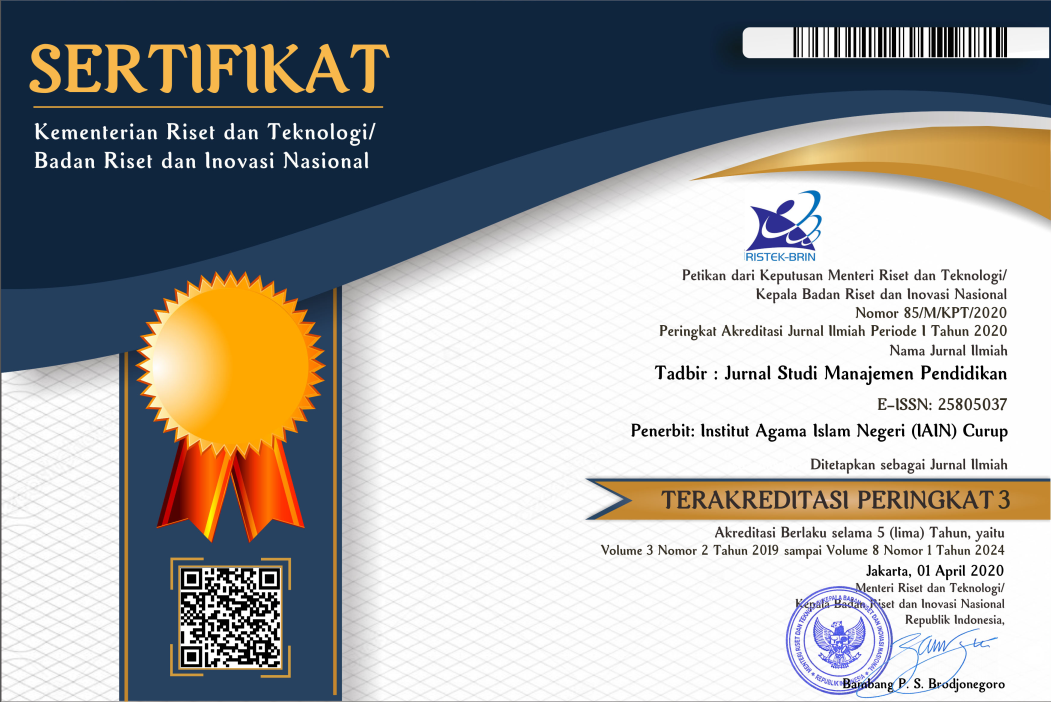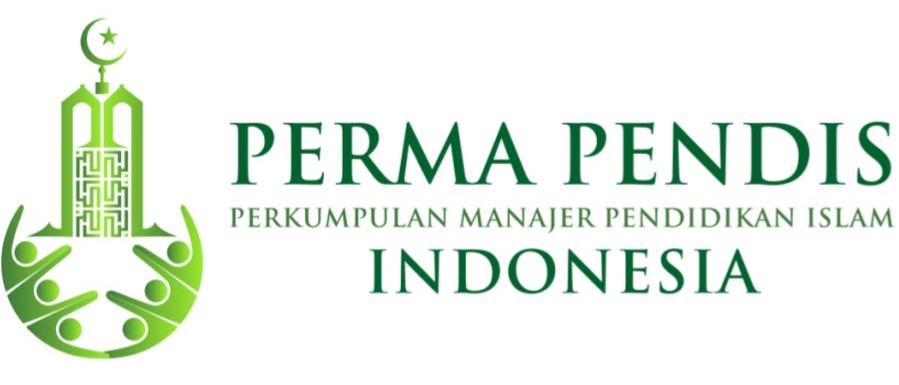The Leadership Role of The Principal in Increasing Admission of New Students
DOI:
https://doi.org/10.29240/jsmp.v5i2.3392Keywords:
Role of the principal, Admission, Task Group, MonitoringAbstract
This study aims to reveal the role of school principals in increasing new student admissions. The method used in this research is qualitative. Collecting data through documentation, observation, and interviews. Respondents include school principals, vice principals, and heads of expertise programs. The results showed that the principal's role in increasing new student admissions was to optimize his function as an educator, which is to always provide guidance, as a manager who always encourages teachers and education personnel, especially those who are included in the committee to carry out their duties in accordance with the plans and rules that have been outlined. in its main duties and functions. As a supervisor, the school principal always monitors, provides input, direction, and motivation to all members of the new student admissions program committee. The principal is also always a role model in discipline, and is always active in establishing relationships with junior high schools in his area. The results of this study are certainly quite inspiring, because the implications can encourage the spirit of school principals in improving the performance of the new student admissions committee in each school.
Downloads
References
Ali, A. (2012). Leadership and its influence in organizations–a review of intellections. International Journal of Learning and Development, 2(6), 73–85.
Bakkenes, I., Vermunt, JD, & Wubbels, T. (2010). Teacher learning in the context of educational innovation: Learning activities and learning outcomes of experienced teachers. Learning and Instruction, 20(6), 533–548.
Brown, LB (1992). Student admission and multicultural recruitment. Journal of Library Administration, 16(1–2), 109–122.
Bruggink, TH, & Gambhir, V. (1996). Statistical models for college admission and enrollment: A case study for a selective liberal arts college. Research in Higher Education, 37(2), 221–240.
Buku, K., Santosa, AB, Sukirman, S., & Hasanah, E. (2021). The Effect of Principal's Leadership and Supervision Competencies on Junior High School Teacher Performance in Nagekeo District. Edumaspul: Journal of Education, 5(1), 530–540.
Cenkseven-Onder, F., & Sari, M. (2009). The Quality of School Life and Burnout as Predictors of Subjective Well-Being among Teachers. Educational Sciences: Theory and Practice, 9(3), 1223–1235.
Cheng, A., Trivitt, JR, & Wolf, PJ (2016). School choice and the branding of Milwaukee private schools. Social Science Quarterly, 97(2), 362–375.
Covey, SR (1992). Principle centered leadership. Simon and Schuster.
Davis, HA (2001). The quality and impact of relationships between elementary school students and teachers. Contemporary Educational Psychology, 26(4), 431–453.
Djam'an, S., & Aan, K. (2010). Qualitative research methodology. Bandung: Alphabeta, 28.
Ellrich, LM (2014). Are SAT scores a strong predictor of student success? A study of education majors, admission variables and the impact of leadership development.
Fathurrochman, I. (2021). Penjaminan mutu pendidikan dalam perspektif zonasi mutu. Jurnal Konseling dan Pendidikan, 9(3), 234-240.
Febriansyah. (2016). Realizing Professional Human Resources in Global Competence. Proceedings of the National Seminar on Education, 570–577.
Folta, SC, Koch-Weser, S., Tanskey, LA, Economos, CD, Must, A., Whitney, C., Wright, CM, & Goldberg, JP (2018). Branding a school-based campaign combining healthy eating and eco-friendliness. Journal of Nutrition Education and Behavior, 50(2), 180–189.
Gurr, D., Drysdale, L., & Mulford, B. (2006). Models of successful principal leadership. School Leadership and Management, 26(4), 371–395.
Juliantoro, OM (2017). The Principal's Role in Improving the Quality of Education. 5(2).
Kavoosi, MC, Elman, NS, & Mauch, JE (1995). Faculty mentoring and administrative support in schools of nursing. SLACK Incorporated Thorofare, NJ.
Kirillov, AV, Vinichenko, MV, Melnichuk, AV, Melnichuk, YA, & Lakina, Y. (2015). Higher education institutions grading: administrative and support personnel. International Journal of Economics and Financial Issues, 5(3S), 173–182.
Kurnia, IH, Santoso, D., et al, Satria, R., Supriyanto, A., Timan, A., Adha, MA, Hatijah, F., Sholeh, M., Zuhriyo Dwi Yazid Zamakhsyah, S., Elyus, DS, Qohar, MA, Puspita, Y., Lestari, Y., Marta, R., Alivermana, W., Safii, R., Noviantiani, R., Harmonika, S., … Widianto, A. (2019). The role of public relations in an effort to increase interest in the registration of new students. Altizam Journal, 1(1), 159–173.
Maduratna, M. (2013). The Role of Principal Leadership in Improving the Effectiveness of Teachers and Elementary Schools 015 Samarinda. EJournal of Public Administration, 1(1), 70–84.
Mukhtar. (nd). Principal's strategy in improving teacher performance at public junior high schools in Masjid Raya District, Aceh Besar District. 103–117.
Nasution, MK (2017). The use of learning methods in improving student learning outcomes. Studia Didactic: Scientific Journal of Education, 11(1), 9–16.
Platow, MJ, Haslam, SA, Reicher, SD, & Steffens, NK (2015). There is no leadership if no-one follows: Why leadership is necessarily a group process. International Coaching Psychology Review, 10(1), 20–37.
Purwanti, S. (2013). The Principal's Leadership Role in Improving Teacher Work Discipline. 1(1), 210–224.
Rahmanto, W., & Darmaji, A. (2017). The Strategy of the Head of Madrasah in Increasing New Student Acceptance in Min Melikan Rongkop Gunungkidul for the 2016/2017 Academic Year. 1–21.
Rusmawati, V. (2013). Principal's Leadership Role in Efforts to Improve Teacher Work Discipline at Sdn 018 Balikpapan. EJournal of Public Administration, 1(2), 395–409.
Setyawan, D., & Santosa, AB (2021). Competence of Principals and Teachers as the Base for Achievement of Education Quality. Educational: Journal of Educational Sciences, 3(5), 3271–3281.
Smith, N. (2013). Educated guesses What is the purpose of education? Stimulus: The New Zealand Journal of Christian Thought and Practice, 20(3), 32–35.
Valeriu, D. (2015). The Aspiration to Success in School and the Need for Performance of the Pupils. Procedia - Social and Behavioral Sciences, 180(November 2014), 549–553. https://doi.org/10.1016/j.sbspro.2015.02.158
Veloutsou, C., Lewis, JW, & Paton, RA (2004). University selection: information requirements and importance. International Journal of Educational Management.
Wechsler, HS (2017). The qualified student: A history of selective college admission in America. Routledge.
Wening, MH, & Santosa, AB (2020). The principal's leadership strategy in facing the digital era 4.0. JMKSP (Journal of Management, Leadership, and Education Supervision), 5(1), 56–64.
Yuliani, T., & Kristiawan, M. (2017). The Principal's Leadership Role in Fostering Social Competence (Prime Service) for School Administration Staff. JMKSP (Journal of Management, Leadership, and Education Supervision), 1(2), 122–132. https://doi.org/10.31851/jmksp.v1i2.1013
Yusdiana, BI, & Hidayat, W. (2018). Analysis of the mathematical reasoning ability of high school students on the limit function material. 1(3), 409–414. https://doi.org/10.22460/jpmi.v1i3.409-414
Zaib, Z., & Harun, H. (2014). Leadership in technical and vocational education: towards excellence human capital. Leadership, 5(23).
Zepeda, SJ (2014). The principal as instructional leader: A handbook for supervisors. Routledge.












 This work is licensed under a
This work is licensed under a 